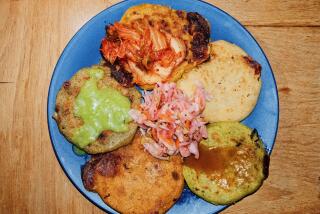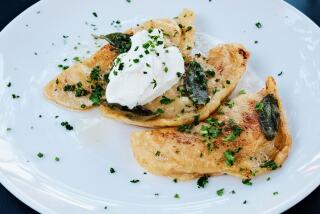Relish the Romance of Spain’s Seductive Spirit
- Share via
SEVILLE, Spain — Anyone doubting that romance is a strong thread in this Andalusian capital’s fabric need only reflect that Don Juans are all namesakes of a noble and profligate native son.
He, along with real life versions of Carmen and Figaro, inspired Mozart, Bizet and Rossini to a quartet of operas that have enthralled music lovers for more than a century.
Countless others have been inspired by the city, either firsthand or through the imagination from afar. Murillo and Velasquez were born and painted here; Cervantes’ quixotic Knight of La Mancha was born in the town’s prison; heroes and harridans, Gypsy rogues and rapscallions have roamed the streets and twisting alleys of its barrios since Roman times, when the Emperors Trajan and Adrian were born in a nearby village.
Sevillanos have always been known as the enemies of haste, a rather sensible outlook when you consider that summer in Andalusia would cause the devil himself to break out a fan.
The seven-century Moorish occupation put its indelible mark on Seville, leaving among other things the 12th-Century, 320-foot Giralda tower, built as the crowning glory of the main mosque.
Few other cities in Spain will reward the dedicated walker so much, with colorful barrios wreathed in geraniums, lovely parks, monuments from a kaleidoscopic past and enough sidewalk cafes to keep your thirst at bay during the trek.
To here: Fly Iberia nonstop to Madrid; TWA and American will get you there with changes. Iberia or Aviaco fly on to Seville in just under an hour.
How long/how much? Any way you look at it, Seville is a three-day city. Cost of accommodations runs the spectrum, starting with good small hotels at inexpensive to moderate rates.
A few fast facts: A dollar recently bought 116 Spanish pesetas, about .0086 each. Best times for a visit are spring and fall; mid-summers are crowded and scorching. Just take a sensible siesta and walk the street’s shady side like natives. Cab fares are moderate, and a horse carriage rents for about $21 an hour (four adults).
Getting settled in: Murillo (Calle Lope de Rueda 7, in Barrio Santa Cruz; $52 double) has been a favorite of ours for two decades. The carved-wood lobby ceiling alone is worth a visit, with every stick of furniture, fixtures, screens, armor, carpets and artwork below in gorgeous harmony with the past. Don’t miss the tiny bar, a masterwork of carved wood.Bedrooms are very simple and contemporary. Breakfast only.
Dona Maria (Don Remondo 19; $85 double) has a location the equal of Murillo, on the edge of the barrio with a rooftop pool you could dive into from the Giralda. The lobby rings a flowery patio and has another magnificent collection of antique santos , grillwork and statuary, plus carved and wrought candelabra. Handsome bedrooms are furnished in traditional style. Breakfast only, with good restaurants nearby.
Hotel Simon (Garcia de Vinuesa 19; $30 double) was the find of the trip, a typical 18th-Century Sevillana town house built around a patio with fountain, and blessed with a delightful little dining room. It’s a few blocks from the cathedral. Bedrooms are a bit austere but neat, and the staff is most friendly. Have a soup-fish-meat-dessert meal at lunch or dinner for $8.50 and count your blessings.
Regional food and drink: Seville claims to have invented the tapa centuries ago, a “lid” of bread placed on the wine glass to keep out flies. Now tapas are mini-hors d’oeuvres of ham, quail eggs, chorizo sausage, fried squid or other seafood, and the famed but simple Spanish tortilla for a hot or cold omelet of potatoes, onions and eggs.
Any bar will have a good selection set out during tapas time: an hour or two before the mid-afternoon lunch or late-evening dinner that Spaniards prefer. The 17th-Century El Rinconcillo bar in Barrio Santa Catalina is said to be the town’s best tapas place, so give it a go.
Huevos a la flamenca is another favorite: eggs poached in a zippy tomato sauce with serrano ham, asparagus, peas and a sprinkling of herbs. And you can’t beat a chilled bowl of gazpacho during torrid July-August.
Good dining: Meson Don Raimundo (Argote de Molina 26) places the emphasis on period Andalusian atmosphere, set in a 17th-Century convent. Enter through a tiny private alley lined with plants and flowers, passing their tapas bar with marvelous tile work and on into the main dining room of Moorish arches, brick walls, fireplace and lots of baroque furnishings.
Don Raimundo’s menu is extensive and imaginative, presenting a clutch of entremets, a half-dozen local soups, plenty of fish and shellfish, plus such tempting dishes as partridge in a sherry sauce, wild duck or pigeon casserole, and wild rabbit with sherry.
Kioskos de las Flores (across the river in Barrio Triana at the foot of Isabel II Bridge) is another find of our latest trip, with the best fried fish in the city at the friendliest prices. Sit in a tiny shedded area or at sidewalk tables and join a mainly local crowd, all of whom seem to be ordering the mixed seafood platter at $5, which will really feed two.
Drink beer or Valdepenas wine while you nibble olives and crackers already on the table, watch children playing on steps to the bridge and wait for the hyperactive waiters scurrying about with brimming plates of fish to place a couple on your table. You won’t find a better combination of food and fun in town.
La Juderia (Cano y Cueto 13 in Barrio Santa Cruz) is a modern version of Andalusian architecture set in the old Jewish quarter near Puerta de la Carne, the butchers’ gate. Bull’s tail, Sevillian-style, is one of the specialties, also scrambled eggs with spinach and crayfish, paella and the ever-present gazpacho.
Going first-class: Hotel Alfonso XIII (Calle San Fernando 2) is the nearest thing to a Moorish potentate’s palace. Built around a huge central patio, Alfonso XIII is an utterly luxurious example of what can be done with polished wood, tiles, majestic staircases and lush carpeting. There is also a pool, gardens, bars and a very formal dining room. This is a hotel that has pampered and pleased guests for six decades, its restaurant vastly improved since our last visit.
On your own: The main problem in Seville is where to start. We suggest the 15th-Century Gothic cathedral, the third largest in Europe, with its breathtaking treasury. Then the nearby Giralda and Patio de los Naranjos, a court of ablutions for the original mosque.
For another treasury, this one of Spanish painters, visit the Fine Arts Museum with its lode of works by Greco, Rivera, Velasquez, Murillo, Goya and lesser lights. Then walk through the Alcazar and its gardens, the beautiful old alleys of Barrio Santa Cruz and perhaps Maria Luisa Park.
Seville has always been Gypsy country, so consider a tablao flamenco, an evening of Gypsy music and dance. Los Gallos (Plaza de Santa Cruz 11) is said to have the purest program of this vivacious folk art.
And you may wish to see the old hangout of the world’s most famous Gypsy. So stroll by the main gate of the old tobacco factory (now Seville University beside Hotel Alfonso XIII) where Carmen is pictured working her wiles with a rose in her teeth. You’ll find all of Seville just as seductive.
For more information: Call the National Tourist Office of Spain at (213) 658-7188, or write (8383 Wilshire Blvd., Suite 960, Beverly Hills 90211) for a brochure on Seville with city plan, others on Andalusia and Spanish cuisine, plus a map of all Spain. Ask for the Seville package.
More to Read
Sign up for The Wild
We’ll help you find the best places to hike, bike and run, as well as the perfect silent spots for meditation and yoga.
You may occasionally receive promotional content from the Los Angeles Times.






